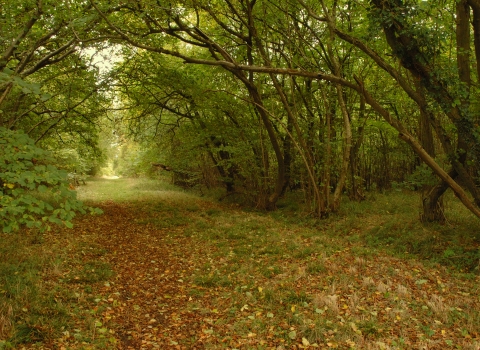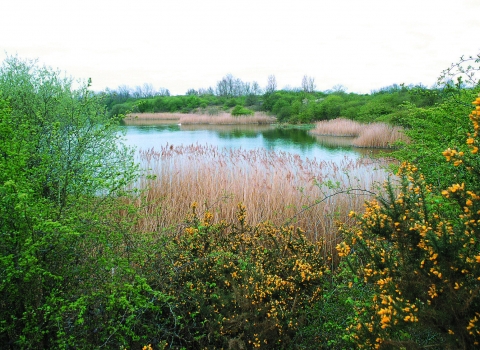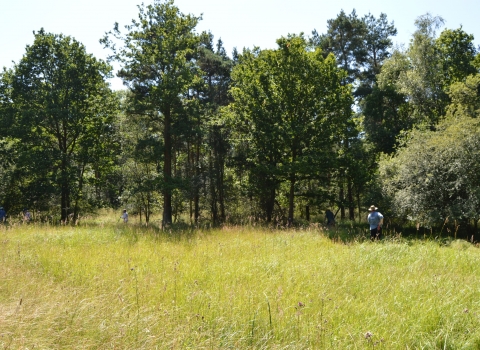No access to Leaches Farm until further notice - National Grid pylon refurbishment works require the temporary closure of the Public Right of Way.
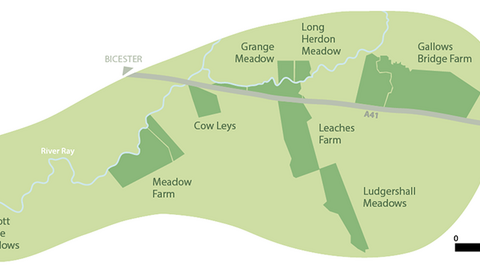
Map of BBOWT sites that make up the Upper Ray Meadows nature reserve, Buckinghamshire
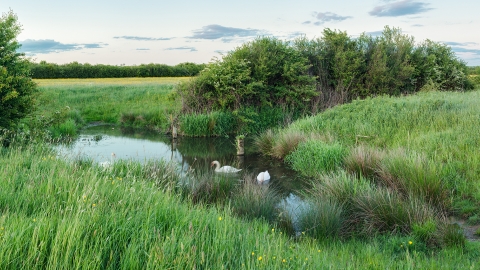
Gallows Bridge Farm nature reserve, part of BBOWT's Upper Ray Meadows complex. Picture: Phil Cutt
Upper Ray Meadows
Know before you go
Dogs
(except on public footpaths)
When to visit
Opening times
Arncott Bridge Meadow - access August-September.Cow Leys, Grange Meadow, Leaches Farm, Long Herdon Meadow, Ludgershall Meadows - access all year.
Dorothy Bolton Meadow - access July-September.
Gallows Bridge Farm - no access except to bird hide.
Leaches Meadow, Three Points Meadow - no access.
Meadow Farm - no public access, open for pre-booked groups and events only.
Best time to visit
January to August (see below for seasonal highlights)About the reserve
Seasonal highlights
- Leaches Farm, Long Herdon and Grange Meadow: flower-rich hay meadows best seen from May to early July.
- Gallows Bridge Farm: flocks of overwintering wildfowl are attracted to flooded meadows from December to February; breeding waders from April to May.
Wet meadows
This patchwork of meadows on the upper River Ray floodplains holds small breeding populations of locally scarce wading birds such as lapwing and curlew. These disappearing species were once common in the English countryside when flood meadows and pastures were far more extensive.
The River Ray is one of the best areas in central England for these species and the Berks, Bucks and Oxon Wildlife Trust ( BBOWT) is working hard to encourage them to stay and breed here. The first curlew usually returns in late February and by early spring displaying lapwing and curlew can be seen across the reserve.
Species-rich grassland
A shocking 97% of wetland grasslands in the UK were lost in the 20th century through drainage and intensive farming. The Upper Ray Meadows are a stronghold for internationally rare species because arable farming in the area is difficult due to frequent flooding and heavy clay soils. Consequently, there are areas of old, unploughed ridge and furrow and in spring and early summer you can see a rich collection of grasses, sedges and meadow plants such as cuckooflower, yellow rattle, meadowsweet and ragged-robin among many other species.
In the summer the drier meadows are ablaze with wild flowers such as black knapweed, great burnet, tubular water dropwort, meadowsweet, tufted vetch and lesser trefoil, attracting large numbers of butterflies and other insects.
Restoring the floodplain
The Upper Ray Meadows Nature Reserve is a core part of BBOWT's Upper River Ray Living Landscape, a Wildife Trust project to create space for wildlife and people together. A major part of this work has been to create a range of features such as shallow pools, scrapes and ditches. These help to retain water and wetness into late spring - a crucial time for feeding wader chicks.
In winter, ducks such as teal and wigeon, together with flocks of lapwing and golden plover feed and roost on the shallow floodwaters and wet meadowland. BBOWT has also created many new freshwater ponds to benefit great crested newts which are present in other ponds in the area. Frogs and toads, dragonflies, damselflies, water beetles and a whole host of other small freshwater insects will also make their homes here.
Wildlife corridors
The extensive flowering and fruiting hedges of blackthorn, hawthorn, field maple, hazel, elm and crab apple also provide food and nest sites for numerous birds, including finches, bunting and warblers, while also acting as wildlife corridors for small mammals. The hedgerows to the west also support small colonies of both black and brown hairstreak butterflies whilst the central hedgerows at Gallows Bridge Farm are kept low to provide a more open aspect to encourage nesting waders.
Coronation Meadow
Upper Ray Meadows is one of three of BBOWT’s most charismatic wildflower meadows that have been named Coronation Meadows. King Charles III, as patron of RSWT, Rare Breeds Survival Trust and Plantlife, initiated the Coronation Meadows project. It celebrates the historic and extraordinary diversity of meadows, and encourages the creation of many more in the next 60 years through seeds and green hay from the Coronation sites.
Coronation Meadows represent a certain ethos; an attitude towards farming, rearing livestock and an appreciation of the value of farmland wildlife that has allowed these fragments of flower rich grassland to survive over the decades.
BBOWT's Chimney Meadows, Moor Copse and Upper Ray Meadows reserves are prime examples of a Coronation Meadow because they are rich in a wealth of wild flowers. On each reserve there are meadows which have been regenerated using green hay from nearby land, a natural spread of species from field to field. The meadows are managed carefully using traditional farming methods, sometimes with rare breed livestock for conservation grazing.
Ancient hedgerows and tracks connect each meadow to the next these are just as important for wildlife as the meadows themselves. They help to create patchworks of habitats greater than their individual parts. Coronation Meadows is supported by Biffa Award.
Parking Information
Directions for the different parts of the reserve:
For Arncott Bridge Meadow, take A41 from Bicester towards Aylesbury; take right turn signed Arncott and Ambrosden. Park on roadside in village, access is approx 0.75 miles south of village, off Ploughley Road. Find using what3words: differ.confused.stiletto
For Cow Leys, from Bicester take A41 towards Aylesbury; after railway bridge take right turn signed for Piddington, reserve immediately on your left, park on soft verge on left. Find using what3words: visa.derailed.reds
For Dorothy Bolton Meadow go along the A41 from Bicester to Aylesbury, take second road on left signed to Marsh Gibbon and park on soft verge 100 m on right. Find using what3words: camper.landowner.rust
For Gallows Bridge Farm continue 1.5 miles and take road on left signed Grendon Underwood, after 100 m turn left and park at end of track. Find using what3words: growl.consonant.pool
For Leaches Farm continue on A41 and park in layby on left just past Leaches Farm Business Centre, access reserve over the stile on the public footpath. Find using what3words: belief.knitted.nobody
For Long Herdon and Grange Meadows continue for 0.75 miles and park on verge 500 m from reserve. Find using what3words: bookings.captive.gifted
For Ludgershall Meadows use parking as for Leaches Farm; on A41, park in layby on left just past Leaches Farm Business Centre. Walk through Leaches Farm reserve and access Ludgershall Meadows through gate at south-east tip of Leaches Farm. Parking on Ludgershall village green is NOT permitted. Find using what3words: constrain.mixture.lemons
For Meadow Farm (no public access, only open for pre-booked groups and events) take A41 from Bicester towards Aylesbury; take B4011 right turn signed for Blackthorn, go past Blackthorn village, and entrance to Meadow Farm on left, park beyond the farmhouse.
Species
Contact us
Environmental designation
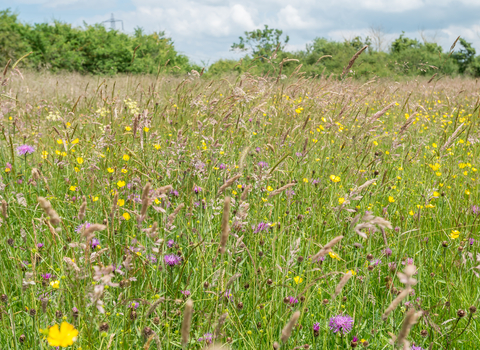
Ludgershall Meadows by Andrew Marshall Go Wild Landscapes
Ludgershall Meadows saved
BBOWT was delighted to purchase Ludgershall Meadows following a major £330,000 fundraising appeal. This 31 hectares of hay meadow and permanent pasture expands our Upper Ray Meadows nature reserve into an even bigger haven for wildlife.
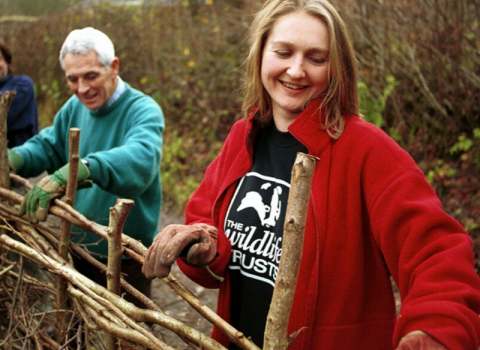
Volunteer with us
Our volunteers help us in so many ways - by working on nature reserves, helping at visitor centres, leading walks, training others and much, much more. Without our volunteers we would not be able to carry out much of our work.
For more information about volunteering for BBOWT, please get in touch with volunteering@bbowt.org.uk

